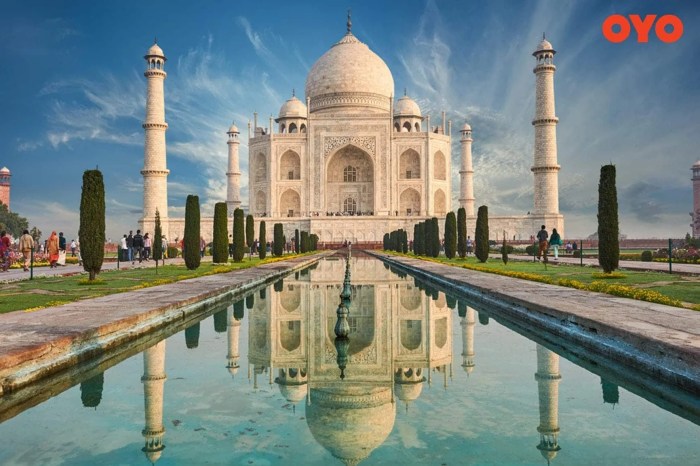
Historic city travel destinations for architecture sets the stage for this enthralling narrative, offering readers a glimpse into a story that is rich in detail and brimming with originality from the outset. From the grandeur of ancient structures to the intricate designs of historical buildings, this exploration promises a journey through time and architectural marvels.
As we delve deeper into the significance of historical architecture in travel destinations and the impact it has on enhancing the outdoor experience, a tapestry of culture and history unfolds before our eyes. Let’s embark on a virtual tour of historic cities that have stood the test of time and continue to inspire awe and admiration.
Historic City Travel Destinations for Architecture
Historical architecture plays a vital role in attracting tourists to travel destinations. It serves as a window to the past, offering insights into the culture, lifestyle, and artistic achievements of bygone eras. The architecture of a city is like a living museum, showcasing the evolution of design, construction techniques, and aesthetic preferences over centuries.
Significance of Historical Architecture
Historical architecture adds depth and character to a city, creating a unique atmosphere that transports visitors back in time. It serves as a tangible link to the past, allowing people to connect with the history and heritage of a place.
The intricate details, craftsmanship, and grandeur of historical buildings often leave a lasting impression on travelers, enriching their overall experience.
Architecture’s Influence on a Historic City
The architecture of a historic city is a key element that contributes to its charm and allure. The blend of architectural styles, from Gothic cathedrals to Baroque palaces, creates a visually stunning landscape that captures the imagination. The layout of streets, squares, and buildings tells a story of urban planning, societal values, and cultural identity, providing a rich tapestry for exploration and discovery.
Preservation Efforts in Historical Buildings
Preserving historical buildings is essential to maintain the authenticity and integrity of a city’s architectural heritage. Many destinations have implemented strict conservation policies and restoration projects to safeguard their valuable historical structures. These efforts involve specialized techniques, materials, and expertise to ensure that the buildings retain their original beauty and significance for future generations to appreciate.
Outdoor Activities

When visiting historic city travel destinations known for their architecture, there are various outdoor activities that visitors can enjoy. The combination of historical buildings and outdoor spaces creates a unique experience for tourists looking to explore these cities.
Walking Tours
- Exploring the city on foot allows visitors to appreciate the intricate details of historical architecture up close.
- Walking tours often include visits to famous landmarks, providing insights into the city’s rich history.
- Architecture enthusiasts can admire the different styles and designs of buildings while strolling through the streets.
Cycling Adventures
- Riding a bike around a historic city offers a different perspective on the architecture and layout of the area.
- Cyclists can cover more ground and explore hidden gems that may not be easily accessible by other modes of transportation.
- Many cities have dedicated bike paths or routes that pass by significant architectural sites, making it a fun and active way to sightsee.
Picnics in Parks
- Many historic cities have beautiful parks or gardens where visitors can relax and enjoy a picnic amidst stunning architectural backdrops.
- Green spaces provide a peaceful retreat from the hustle and bustle of the city, allowing visitors to appreciate the architecture in a serene setting.
- Picnicking in historic parks offers a combination of natural beauty and architectural wonders, creating a memorable experience for travelers.
Travelling and Hotels: Historic City Travel Destinations For Architecture
When visiting historic city travel destinations, one of the key aspects to consider is the type of accommodations available in these areas. Whether you prefer luxury hotels, boutique inns, or budget-friendly options, historic cities offer a variety of choices to suit every traveler’s needs.
Types of Accommodations
In historic city travel destinations, you can find a range of accommodations to choose from, including charming bed and breakfasts located in centuries-old buildings, grand historic hotels with ornate architecture, and modern boutique hotels seamlessly blending contemporary design with historic charm.
Additionally, some historic cities offer the unique experience of staying in restored castles, palaces, or manor houses, providing guests with a glimpse into the past.
Hotel Options in Historic vs. Modern Cities
When comparing hotel options between historic and modern cities, the main difference lies in the architectural style and historical significance of the accommodations. In historic cities, hotels often boast unique features such as original frescoes, antique furnishings, and architectural details that reflect the city’s heritage.
On the other hand, hotels in modern cities tend to focus on sleek design, cutting-edge technology, and contemporary amenities to cater to the needs of modern travelers.
Staying in a Hotel with Historical Significance
Choosing to stay in a hotel with historical significance can enhance your travel experience by immersing you in the rich history and culture of the destination. These hotels often offer guided tours, historical exhibitions, and themed events that allow guests to learn more about the area’s past while enjoying modern comforts.
From former royal residences to iconic landmarks turned luxury hotels, staying in a property with historical significance adds a unique touch to your journey and creates lasting memories.
Holidays and Vacations
Historic cities are popular choices for holidays and vacations due to their rich cultural heritage, stunning architecture, and immersive historical experiences. Travelers are drawn to these destinations to explore centuries-old buildings, walk through cobblestone streets, and delve into the past of these iconic locations.
Tips for Planning a Memorable Holiday in a Historic City
When planning a trip to a historic city, consider the following tips to make your vacation truly memorable:
- Research the city’s history and famous landmarks before your visit to appreciate the significance of the sites you’ll be exploring.
- Book guided tours or audio guides to gain deeper insights into the historical significance of the architecture and monuments.
- Stay in a historic hotel or accommodation to enhance your overall experience and immerse yourself in the city’s ambiance.
- Try local cuisine and traditional dishes to get a taste of the city’s culinary heritage.
- Participate in cultural events, festivals, and celebrations to connect with the local community and experience the city’s vibrant spirit.
Festive Atmosphere in Historic Cities During Holiday Seasons
During holiday seasons, historic cities come alive with festive decorations, traditional markets, and special events that celebrate the season. The streets are adorned with lights, and historic buildings are illuminated, creating a magical atmosphere for visitors. Christmas markets, music concerts, and holiday parades add to the festive charm of these cities, inviting travelers to join in the merriment and create lasting memories.
Vacation Plans
Planning a vacation to a historic city requires careful consideration to make the most of your trip. Here is a step-by-step guide to help you organize a memorable vacation experience.
Step-by-Step Guide for Organizing a Vacation to a Historic City
When planning a vacation to a historic city, consider the following steps to ensure a smooth and enjoyable trip:
- Research the destination’s historical sites and landmarks to prioritize your must-see attractions.
- Book accommodations in advance to secure a comfortable stay in the heart of the city.
- Create a flexible itinerary that allows for both structured tours and spontaneous exploration.
- Plan transportation options to easily navigate the city and its surrounding areas.
- Pack appropriate clothing and accessories for varying weather conditions and cultural activities.
Cultural Experiences to Include in Your Vacation Plans
Immerse yourself in the rich cultural heritage of a historic city by incorporating these experiences into your vacation plans:
- Attend local festivals and events to witness traditional music, dance, and cuisine.
- Visit museums, art galleries, and cultural centers to learn about the city’s history and artistic contributions.
- Participate in guided tours led by knowledgeable experts to gain insights into the city’s architectural marvels and cultural significance.
- Engage with local communities through workshops, classes, or volunteer opportunities to connect with the city’s residents and traditions.
Balance Relaxation and Exploration in a Historic City Vacation
Finding the perfect balance between relaxation and exploration is key to enjoying a historic city vacation to the fullest:
- Allocate time for leisurely strolls through historic neighborhoods and scenic parks to unwind and appreciate the city’s beauty.
- Schedule breaks between sightseeing activities to relax at charming cafes, local markets, or tranquil gardens.
- Include spa treatments, wellness activities, or cultural performances in your itinerary to rejuvenate your body and mind during your vacation.
- Embrace the opportunity to savor authentic local cuisine at renowned restaurants or cozy eateries for a well-rounded culinary experience.
Travel Spot
When it comes to hidden gems for architecture enthusiasts, one lesser-known historic city that stands out is Ghent in Belgium. This city is often overshadowed by Brussels and Bruges, but it boasts a rich architectural heritage that is worth exploring.To discover unique architectural features in Ghent, take a stroll through the historic city center.
Marvel at the well-preserved medieval buildings, such as the Gravensteen Castle and the Belfry of Ghent. Don’t miss the stunning Saint Bavo’s Cathedral with its intricate Gothic architecture and famous artwork, including the Ghent Altarpiece.Visiting a historic city off the beaten path like Ghent has its benefits.
You can avoid crowds and have a more authentic experience, immersing yourself in the local culture and history without feeling overwhelmed by tourists. Additionally, you may discover hidden architectural treasures that are not as well-known but equally impressive.
Exploring Architectural Gems in Ghent
When exploring Ghent, be sure to visit the picturesque Graslei and Korenlei along the banks of the Leie River. These well-preserved medieval guild houses provide a glimpse into the city’s mercantile past. Take a canal cruise to admire the architecture from a different perspective and capture stunning views of the cityscape.Don’t forget to wander through the charming Patershol neighborhood, known for its narrow cobblestone streets and historic houses.
Stop by the Great Butchers’ Hall, a unique blend of Gothic and Renaissance architecture that once served as a meat market. Explore the vibrant street art scene in Ghent, where modern murals coexist with centuries-old buildings, creating a fascinating juxtaposition of styles.In conclusion, Ghent is a hidden architectural gem that offers a wealth of history and culture for those willing to venture off the beaten path.
By exploring this historic city, you can uncover unique architectural features and immerse yourself in a truly authentic experience.
Best Travel Backpack

When exploring historic cities known for their stunning architecture, having the right travel backpack can make a significant difference in your experience. Here, we will discuss the essential items to pack in a travel backpack for architecture-focused trips, provide tips on choosing the best travel backpack, and highlight the importance of comfort and functionality.
Essential Items to Pack
- Camera or smartphone for capturing architectural marvels
- Comfortable walking shoes for exploring on foot
- Sunscreen and sunglasses for protection from the sun
- Reusable water bottle to stay hydrated throughout the day
- Lightweight jacket or scarf for changing weather conditions
- Travel guide or map of the historic city
Tips for Choosing the Best Travel Backpack
- Consider the size of the backpack based on the duration of your trip
- Look for a backpack with multiple compartments for easy organization
- Choose a backpack with padded straps for comfort during long walks
- Opt for a water-resistant backpack to protect your belongings
- Check the weight of the backpack when empty to ensure it is lightweight
Importance of Comfort and Functionality
When exploring historic cities with a focus on architecture, comfort and functionality are key aspects to consider in a travel backpack. A comfortable backpack with proper padding and adjustable straps will ensure that you can carry your essentials without straining your back or shoulders.
Additionally, a functional backpack with well-designed compartments and pockets will help you stay organized and easily access your belongings while on the go.
Travel Tip
When navigating historic cities with intricate architecture, it’s essential to take the time to interact with locals to learn more about the city’s history. Locals often have valuable insights and stories that can enhance your travel experience and deepen your appreciation for the historical sites you visit.
Additionally, showing respect for historical sites by following any rules or guidelines in place helps preserve these important landmarks for future generations.
Interacting with Locals
Engaging with locals can provide a unique perspective on the history and culture of a historic city. Consider visiting local markets, attending cultural events, or joining guided tours led by residents to gain a deeper understanding of the area’s heritage.
Respecting Historical Sites
When exploring historic sites, remember to follow any posted rules regarding behavior, photography, and preservation efforts. Avoid touching or climbing on delicate structures, and be mindful of the impact your visit may have on these sites. By respecting the history and significance of these locations, you contribute to their preservation for future visitors to enjoy.
Travel News

In recent developments, there has been a growing focus on the preservation of historical architecture in popular travel destinations around the world. Governments and organizations are taking proactive steps to ensure that these architectural gems are protected and maintained for future generations to appreciate.
Preservation Efforts
- Many historic cities are implementing strict regulations to prevent the destruction or alteration of important architectural landmarks.
- Restoration projects are underway to revitalize ancient buildings and ensure their structural integrity for years to come.
- Collaborations between local communities, preservationists, and governments are helping to raise awareness about the importance of architectural heritage.
Upcoming Events
- Several historic cities are gearing up to celebrate their architectural heritage with festivals and events that showcase the unique design and history of their buildings.
- Architectural walking tours are being organized to provide visitors with a deeper understanding of the significance of the structures they encounter.
- Special exhibitions and lectures are planned to educate the public about the cultural and historical value of architectural treasures.
Architectural Discoveries, Historic city travel destinations for architecture
- New archaeological findings in historical locations are shedding light on the intricate construction techniques and design aesthetics of ancient civilizations.
- Researchers are uncovering hidden architectural gems that have been buried beneath centuries of debris, revealing the rich architectural history of these sites.
- Advancements in technology, such as 3D scanning and virtual reality, are being used to document and preserve architectural wonders that are at risk of deterioration or destruction.
Best Travel Destinations
When it comes to historic city travel destinations known for their architecture, there are several iconic places around the world that stand out for their beauty and historical significance. From ancient ruins to medieval structures, each destination offers a unique architectural style that tells a story of its own.
Top Historic City Travel Destinations for Architecture
Here are some of the top historic city travel destinations known for their remarkable architecture:
- Rome, Italy: Known for its ancient Roman ruins, Renaissance palaces, and Baroque churches, Rome is a treasure trove of architectural wonders.
- Paris, France: With iconic landmarks like the Eiffel Tower, Notre Dame Cathedral, and the Louvre Museum, Paris is a city that showcases a mix of Gothic, Baroque, and Neoclassical styles.
- Istanbul, Turkey: The city where East meets West, Istanbul boasts stunning examples of Byzantine, Ottoman, and Islamic architecture, such as the Hagia Sophia and the Blue Mosque.
- Barcelona, Spain: Home to the unique architectural creations of Antoni Gaudí, including the Sagrada Familia and Park Güell, Barcelona is a city that pushes the boundaries of design.
Comparing Architectural Styles in Different Historic Travel Destinations
Each historic travel destination has its own distinct architectural style that reflects the culture and history of the region. While Rome showcases grandeur and classical elegance, Barcelona embraces whimsical and unconventional designs. Paris exudes romance and sophistication, while Istanbul boasts a rich tapestry of influences from various civilizations.
Personal Recommendations for the Best Travel Destinations based on Architectural Beauty
For travelers who appreciate architectural beauty, Rome and Paris are must-visit destinations. The ancient ruins of Rome and the iconic landmarks of Paris offer a visual feast for architecture enthusiasts. Additionally, Barcelona’s avant-garde designs and Istanbul’s rich architectural heritage make them top choices for those seeking unique and inspiring architectural experiences.
Last Point
In conclusion, Historic city travel destinations for architecture offer a blend of beauty, history, and cultural richness that captivates travelers seeking a deeper connection with the past. Whether you’re drawn to the ornate details of Gothic cathedrals or the minimalist charm of modernist buildings, these destinations hold a treasure trove of architectural wonders waiting to be explored.
Plan your next adventure to immerse yourself in the timeless allure of historic city travel destinations for architecture.
FAQ Guide
What makes historic city travel destinations ideal for architecture enthusiasts?
Historic cities offer a unique blend of architectural styles and historical significance that appeal to those passionate about the built environment.
How does weather impact outdoor activities in historical locations?
Weather can influence the accessibility and enjoyment of outdoor activities in historic cities, so it’s essential to plan accordingly.
What are some tips for planning a memorable holiday in a historic city?
Researching the city’s historical sites, booking accommodations in advance, and exploring off-the-beaten-path locations can enhance your holiday experience.
Why is it important to respect historical sites while traveling?
Respecting historical sites preserves their integrity for future generations and honors the cultural heritage they represent.
What are some recent developments in the preservation of historical architecture in travel destinations?
New conservation efforts, restoration projects, and educational initiatives are underway to safeguard historical architecture in travel destinations for future visitors to appreciate.







